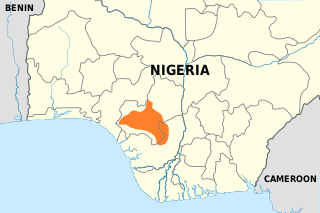Edoid language spoken in Nigeria
Edo [2] (with diacritics, Ẹ̀dó), colloquially or incorrectly called Bini (Benin), is a language spoken in Edo State, Nigeria. It is the native language of the Edo people and was the primary language of the Benin Empire and its predecessor, Igodomigodo for thousands of years. Edo is the language spoken in Benin City and the surrounding cities and local governments found in the Southern part of the State.
Distribution
Most of the Edo language-speakers live in the Southern parts of Edo State, Nigeria.The current state: Edo State derives its name from the Edo speaking people of the state. A smaller number of Edo speakers are also found in Delta State and Ondo State and in other parts of Nigeria.
Edo is an Edoid language. This languages are also spoken in Rivers State and Bayelsa State, Nigeria.
Phonology
Vowels
There are seven vowels, /i e ɛ a ɔ o u/, all of which may be long or nasal, and three tones.
Consonants
Edo has a rather average consonant inventory for an Edoid language. It maintains only a single phonemic nasal, /m/, but has 13 oral consonants, /r, l, ʋ, j, w/ and the 8 stops, which have nasal allophones such as [n, ɲ, ŋʷ], and nasalized allophones [ʋ̃, j̃, w̃] before nasal vowels.
The three rhotics have been described as voiced and voiceless trills as well as a lax English-type approximant. However, Ladefoged[3][page needed] found all three to be approximants, with the voiced–voiceless pair being raised (without being fricatives) and perhaps at a slightly different place of articulation compared to the third but not trills.
Phonotactics
Syllable structure is simple, being maximally CVV, where VV is either a long vowel or /i, u/ plus a different oral or nasal vowel.
Orthography
The Edo alphabet has separate letters for the nasalised allophones of /ʋ/ and /l/, mw and n:
| A |
B |
D |
E |
Ẹ |
F |
G |
Gb |
Gh |
H |
I |
K |
Kh |
Kp |
L |
M |
Mw |
N |
O |
Ọ |
P |
R |
Rh |
Rr |
S |
T |
U |
V |
Vb |
W |
Y |
Z
|
| /a/ |
/b/ |
/d/ |
/e/ |
/ɛ/ |
/f/ |
/ɡ/ |
/ɓˠ/ |
/ɣ/ |
/ɦ/ |
/i/ |
/k/ |
/x/ |
/kp/ |
/l/ |
/m/ |
/ʋ/ |
/l/ |
/o/ |
/ɔ/ |
/p/ |
/r/ |
/ɹ̝̊/ |
/ɹ̝/ |
/s/ |
/t/ |
/u/ |
/v/ |
/ʋ/ |
/w/ |
/j/ |
/z/
|
Long vowels are written by doubling the letter. Nasal vowels may be written with a final -n or with an initial nasal consonant. Tone may be written with acute accent, grave accent, and unmarked, or with a final -h (-nh with a nasal vowel).
